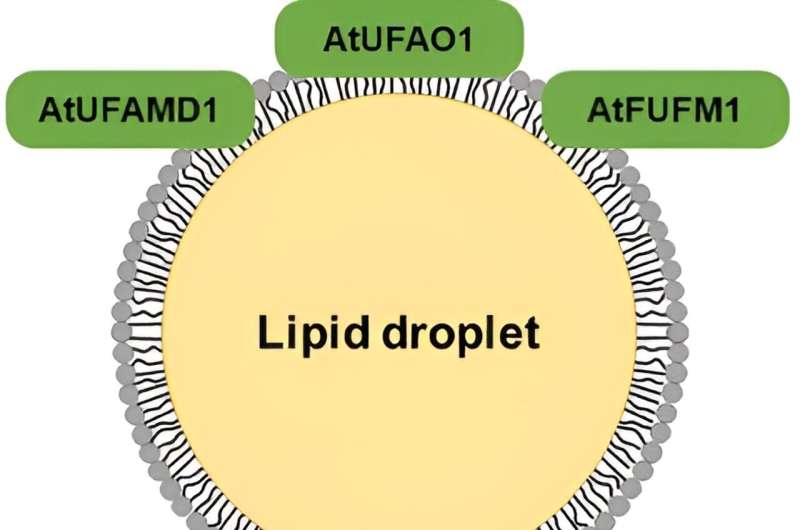This article has been reviewed according to Science X's editorial process and policies. Editors have highlighted the following attributes while ensuring the content's credibility:
fact-checked
peer-reviewed publication
trusted source
proofread
Unveiling the molecular functions of lipid droplet proteins in Arabidopsis thaliana leaves

Lipids are biomolecules essential for the proper functioning of the living cell. They are found in the cell membranes and are also integral components of cell signaling pathways. Plant cells possess subcellular structures or organelles called lipid droplets (LDs) in the leaves and seeds, which store excess lipids (fats).
Recent studies have shown that LDs also localize unique plant proteins that perform essential molecular functions. For example, seed LDs localize plant proteins called oleosins, which help the seeds weather freezing temperatures and germinate properly.
With an expanding body of proof that LDs are not just organelles for carbon storage but may also perform essential molecular functions, a group of researchers from Japan sought to understand the role of the relatively unexplored leaf LDs.
Associate Professor Takashi L. Shimada, an LD expert affiliated with Chiba University, explains the motivation behind their research. "We have a limited understanding of the functions of leaf LDs—why do plant leaves accumulate LDs at all? We believe the answer to this fundamental question would also contribute to lipid production technology."
In a new study published in Frontiers in Plant Science, Dr. Shimada and his research group showed that leaf LDs localized myosin binding proteins essential for intracellular movements and enzymes that catalyze furan fatty acid biosynthesis—a type of fat production in living cells—highlighting the potential and previously undiscovered molecular functions of LDs.
This research was led by Dr. Shimada, who is associated with the Graduate School of Horticulture, Plant Molecular Science Center, and Research Center for Space Agriculture and Horticulture at Chiba University, Japan.
His research group also involved Mr. Yuto Omata from the Faculty of Horticulture, Chiba University, who is the first author of this study, along with Dr. Emi Mishiro-Sato, lecturer at World Premier International Research Center Initiative-Institute of Transformative Bio-Molecules, Nagoya University, and Dr. Ikuko Hara-Nishimura and Dr. Haruko Ueda from the Faculty of Science and Engineering, Konan University in Japan.
The researchers used an Arabidopsis plant model mutated to accumulate LDs in the leaves called Arabidopsis thaliana mutant high sterol ester 1. Dr. Shimada adds, "This Arabidopsis plant mutant model also serves as a valuable resource for further studying the leaf LD proteome."
Further, the researchers isolated these leaf LDs and used mass spectrometry to identify associated proteins. They found 3,206 candidate proteins. They focused on 31 candidate proteins to test associated behavior in leaf LDs. They attached a fluorescent marker to these proteins to facilitate microscopic observations.
The fluorescence microscopy revealed the presence of MYOSIN BINDING PROTEIN14 (MYOB14) and two uncharacterized proteins in the leaf LDs under investigation. Further examination narrowed down the MYOB family members localized to leaf LDs: MYOB1, MYOB2, MYOB3, and MYOB5.
The researchers also identified the two uncharacterized proteins as resembling enzymes for furan fatty acid biosynthesis, suggesting a potential link between leaf LDs and the type of fatty acid production.
Despite the progress made in this study, Dr. Shimada cautions, "We need to identify additional leaf LD proteins to resolve the molecular and physiological functions of leaf LDs."
Nonetheless, the study paves the way for future research in leaf LDs—a relatively untapped plant resource—that could revolutionize lipid production and associated industries, all thanks to the efforts of Dr. Shimada and his team.
More information: Yuto Omata et al, Lipid droplets in Arabidopsis thaliana leaves contain myosin-binding proteins and enzymes associated with furan-containing fatty acid biosynthesis, Frontiers in Plant Science (2024). DOI: 10.3389/fpls.2024.1331479
Journal information: Frontiers in Plant Science
Provided by Chiba University




















